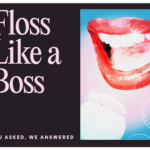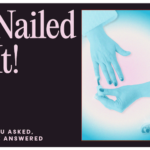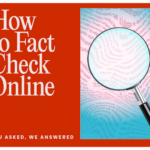Samantha Coxe
Founder + CEO of Flaus
-
You Asked We Answered

Alexa, play My Shiny Teeth and Me. ✨ Once that banger is on full blast, get ready for your teeth to twinkle, just like the stars in space with Samantha Coxe (she/her), founder + CEO of Flaus—the world’s first eco-friendly, electric flosser. Before we hear any groaning (ok, guilty!), you should know that Samantha hated flossing at one point, too. “After leaving a dentist appointment one day with 10 cavities, my dentist and I both knew I’d been fibbing about my flossing habits,” she says. “They begged me to start flossing, but I couldn’t stand how annoying it was! It was painful, time-consuming, difficult, and gross. I realized then that my electric toothbrush built my consistent brushing routine, so I thought buying an electric flosser would do the trick. Much to my surprise, nothing existed and that’s when the lightbulb went off. Today, Flaus is on a mission to help people and their oral health by transforming flossing from a dreadful chore into a delightful ritual.”
As the great Chip Skylark once said, “My shiny teeth, I floss them so they’ll grow to be real strong.” Which is exactly what Samantha wants all of y’all to do. Below, she shares a few facts for flossing that won’t cause a major headache. Or should we say… toothache? 🦷🪥😁
How does an electric flosser hold up to a standard one?
Your toothbrush only cleans 60% of your teeth—and for the other 40%, that’s where flossing comes in. The reason why you’d go from a manual flosser to an electric flosser is the same reason why you’d go from a manual toothbrush to an electric toothbrush. Our revolutionary technology makes flossing quick, easy, and comfortable in 60 seconds or less. The key features include 18k sonic vibrations that help to get between tight teeth, stimulate your gums, and disrupt biofilm, as well as a rechargeable battery and recyclable Flaus Heads that use 95% less floss than traditional string floss and 30% less plastic than floss picks.
How is your product more accessible than traditional flossers?
Although flossing plays such an important role in your health, it’s an ableist activity. There are many people who cannot floss due to fine motor dexterity impairments or disabilities such as arthritis, MS, cerebral palsy, stroke, etc. Our soft touch, ergonomic handle makes flossing simple by allowing you to easily access all areas of your mouth, including your back molars.
A ton of people totally lie when talking to their dentist about their flossing habits. (Whoops!) But, why is flossing a must and not a maybe for our health?
Seventy percent of Americans don’t floss regularly, 32% don’t floss at all, and 27% of the ones who say they do are lying about it. While there are a dozen reasons why we hate flossing (see: it’s tedious, it makes your gums bleed, it hurts your fingers, it’s gross, does it even work?), all of them can be encompassed with the single fact that the flossing experience is overdue for innovation. And, flossing is not just something you do to keep cavities away. From heart health to brain health to skin health—not flossing has been tied to heart disease, diabetes, oral cancer, dementia, Alzhiemer’s, and acne. Over 50% of American adults have early signs of gum disease. When asked to choose between brushing and flossing, many dental professionals will choose flossing as the more critical task.
Ok, now let’s talk about the act of flossing. What’s the correct way to do it?
Use your opposing teeth on the Flaus bite pad to gently roll the Flaus Head between your teeth. Let the sonic vibrations work the floss between tight teeth (never snap or force the floss, as this may cut or bruise the gums). Next, slide the Flaus Head gently up-and-down against both sides of each tooth. As you approach the gumline, gently curve the floss around the base of each tooth to create a “C” shape, making sure you go beneath the gum line. Repeat the steps as you move tooth to tooth, rinsing under water to remove any debris or blood.
When exactly should we floss?
The best time to floss is whenever you have time. While there’s no definitive answer, flossing either in the morning or at night can be effective for maintaining good dental health. Some individuals prefer flossing at night to remove plaque and food particles accumulated throughout the day, while others opt for flossing in the morning to address bacteria build-up overnight and prevent bad breath. Ultimately, consistency and thoroughness in flossing are more important than the specific time of day. That said, flossing too much or incorrectly can cause damage to your gums, so it’s important to not overdo it. We recommend flossing before brushing your teeth as it helps to loosen plaque and debris, making your brushing more effective.
Since flossing isn’t everyone’s fave activity, do you have any tips for making it a habit?
Two things that have helped me are:
1. Habit stacking. Pair your flossing with another thing that’s already a staple in your routine so you’re less likely to forget. For example, always floss right before you brush your teeth or put on your daytime/nighttime skincare. Since you already brush/moisturize daily, you’re more likely to floss daily, because it’s already part of your regime.
2. Having an accountability buddy. You’re way more likely to continue and create a new habit with the support of a friend or someone who can hold you accountable.
There is so much stigma around oral health, especially for those with disabilities. What would you like to see more of from the dental industry when it comes to that?
Oral care is self-care, and everyone (regardless of ability) deserves access to it. Those with disabilities are often overlooked, but are more than worthy of serving with product innovation. After discovering that we had a handful of blind customers, we immediately brought the accessibility community into our product development and incorporated braille throughout our packaging. While these adjustments had a small impact on our product costs, they make a huge difference for members of the accessibility community. I’d love to see more companies incorporate accessibility into their product and brand pillars, as well as more awareness that surrounds the ableism of many everyday tasks we take for granted such as flossing.



